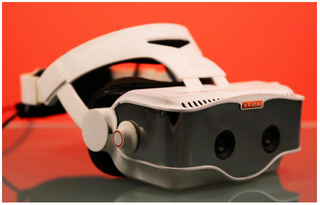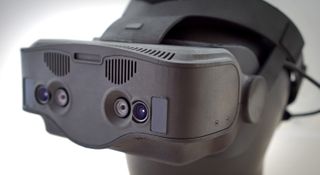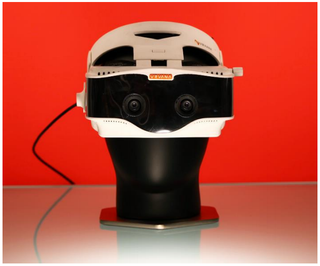Vrvana Totem Mixed Reality HMD Prototype: Beyond Expectations

Immersed 2016 was filled with interesting and exciting exhibits for attendees and the public to experience. There were a dozen Vive setups, a demo from Immersion Vrelia showing off its latest HMD, 360° camera hardware and software, a bow and arrow VR accessory, and more. But the Vrvana Totem mixed reality HMD is the most impressive thing I saw at the show.
We spoke with Vrvana in February about its mixed reality headset, but we hadn’t had the opportunity to try it until now. I expected good things from the Totem, but I wasn’t expecting it to knock my socks off the way it did.
Shoestring Beginnings
Vrvana started on a shoestring budget. CEO Bertrand Nepveu and his four partners founded the company in 2006 with some of his “family money.” Throughout the years, the company received investments from family and friends to keep the company afloat. Nepveu told us that he struggled to find capital funding for his company for years, but that changed when Facebook purchased Oculus.
Suddenly, venture capitalist firms were interested in VR and AR technologies, and they came knocking. A significant investment from a VC firm brought Vrvana’s total funding to a little less than $2 million, which is an incredibly small sum for a company that’s been around for a decade and hasn’t produced a revenue generating product yet. That’s about to change, though. The Totem is currently in pre-production, and the first 50 units will go out to B2B customers before the end of the year.
The Vrvana Totem HMD combines the best of virtual reality and augmented reality in one unit. It offers full VR capabilities, but it also includes binocular pass-through cameras that enable augmented reality features. The headset can seamlessly transition from AR to VR. And because it’s screen-based AR, not projected images like the Hololens, the field of view isn’t limited to a small section of your vision. With the Totem HMD, you get the same FOV in AR as you do in VR— and it’s wide.
What’s Inside?
The Totem headset features a single 1440p display, which is quite a bit higher-resolution than the dual-display setups from Oculus and HTC. The Totem offers 1280 x 1440 per eye, whereas you get 1080 x 1200 per eye from the Rift and Vive. The pre-production model operates at 75Hz, but Vrvana is in discussion with panel manufacturers to secure 90Hz displays for the production model.
Vrvana also created a custom lens design for the Totem. The company designs everything in-house, and one of its founders spent 15 years in the camera industry, so he used that expertise to develop a Fresnel aspherical lens combo that produces a 120-degree FOV. The camera optics are also setup to capture 120 degrees so the pass-through video matches the real-world environment.
Stay on the Cutting Edge
Join the experts who read Tom's Hardware for the inside track on enthusiast PC tech news — and have for over 25 years. We'll send breaking news and in-depth reviews of CPUs, GPUs, AI, maker hardware and more straight to your inbox.

The front of the Totem HMD features four cameras. Two video cameras capture the scene around you, and two infrared cameras perform spatial and hand tracking. The HMD also features three IR illuminators on each side of the cameras to improve their accuracy. Nepveu said the pre-production model would also include a front mounted “speckle pattern” laser that will help triangulate depth information.
Inside the Totem, you’ll find a custom FPGA that “does all the mixed reality magic” and an IMU to keep track of inertial movements.
The head mounting system on the Totem HMD closely resembles Sony’s solution for the PSVR. Instead of strapping the headset to your face, the Totem rests most of the weight on your forehead and anchors it low behind your head. The strap expands to make it easy to slip the HMD onto your head, and a dial on the back lets you lock it in place.
| Specifications | |
|---|---|
| Pass-Through Cameras | 1440p QHD 75Hz RGB ultra low latency pass-through (90hz possible) |
| Tracking Cameras | Infra-Red, 720p HD 60Hz Mono |
| Onboard Processing | Vrvana Mixed Reality Processor |
| Display | 1440p QHD OLED, 75Hz in low persistence (90hz possible) |
| Lens | Fresnel & aspherical compound lens |
| FOV | 120° |
| IPD | 55-72mm (with mechanical adjustment) |
| Tilt Angle | 0°-10° (comfort adjustment) |
| IMU | (Head Tracking) |
| Gyro | 1kHz |
| Accelerometer | 6kHz |
| Magnetometer | 100Hz |
| I/O ports (single cable) | DisplayPort 1.2a |
| Row 13 - Cell 0 | USB 3.0 |
| Row 14 - Cell 0 | Power |
| Audio | 3.5mm jack Binaural HRTF |
| Row 16 - Cell 0 | 1 user microphone |
| Row 17 - Cell 0 | 2 environment microphones |
| Application | High performance AR & VR |
| Content Creation | Vrvana Unreal Plugin |
| Row 20 - Cell 0 | Vrvana Unity Plugin |
| Row 21 - Cell 0 | Vrvana SDK |
| Row 22 - Cell 0 | OpenVR / SteamVR compatibility for Games & Applications |
| Row 23 - Cell 0 | More to come |
| Wireless | Bluetooth 4.1 Dual Mode/BLE |
| Row 25 - Cell 0 | Wi-Fi 802.11n |
| Power Requirements | 100V / 240V AC |
| Row 27 - Cell 0 | 60Hz / 50Hz |
Let’s Do This!
Nepveu put the Totem on my head, and I was immediately surprised to see the real world in front of my eyes—on a screen. What I saw on the screen was dark, yet clearly my real surroundings. And I had a true sense of depth because of the dual cameras. We were in a dark room with black walls, which I suspect played a role in the darkness of the screen, but I would have to try the HMD in a brighter environment to confirm that theory.
Moments after putting the Totem on my head, Nepveu told me to reach out and press start, which demonstrated the hand tracking system. He then handed me a booklet of papers and told me to flip it over. The pages each have 12 unique QR codes, and when I glanced at them at the correct angle, a 3D object appeared on top. The first page was a model of the Delorean from Back To The Future, into which I could lean and inspect the interior. The model wasn’t interactive, but Nepveu said that it eventually would be.
The subsequent pages included a model of a Pikachu, a 3D rendering of some Dewalt tools, and a lightsaber. Nepveu used the Dewalt drill to demonstrate that Totem can replicate presence in AR. He took the page and tried to stick the drill into my face, which made me lurch backward.
The final page featured an attack helicopter, and just when I thought it was over, Nepveu blew my mind once again. He handed me an Xbox 360 controller and said, "Want to fly it?" When he took away the QR codes, the chopper was left in front of my face. I could fly this 3D model of a helicopter anywhere in the room with no restrictions (aside from the physical space that I was in). The helicopter could reach the ceiling above or fly below the table. Once I had the controls worked out, Nepveu hit the space bar to transition the environment to full VR.
Suddenly I found myself flying a digital RC helicopter in a canyon and firing at turrets that opened fire on me first. The demo featured a projected first person view of the chopper’s perspective that I could use to make aiming easier.
The Next Steam VR HMD?
The Totem HMD that Vrvana brought to Immersed 2016 is one of the final prototype models. Vrvana 3D-printed the structure and assembled the HMD by hand, so, it’s a little rough around the edges. But Nepveu said that the shells for pre-production kits are cast from silicone molds, so the quality will compare to a production product. If all goes well with the initial run, the company will finalize tooling and begin production in Q1 2017.

The production version will also have at least one major feature that the pre-production model doesn’t: Vrvana is currently involved in the second round of lighthouse certifications and plans to integrate full lighthouse roomscale tracking into the final product. Vrvana plans to use lighthouse to complement its existing inside-out tracking solution, which will open the Totem up to practically all Steam content (Totem is OpenVR compatible) as well as tracked controllers such as the Vive’s wands. The experimental Vive controllers that Valve recently previewed would go especially well with Vrvana’s hand tracking solution.
The Totem is launching as an enterprise solution because large scale businesses can afford to pay the high price for low production hardware. Nepveu said that it’s possible to bring the costs down enough to sell for $400-500, but that would require the production of millions of units. Vrvana doesn’t have the capital to produce millions of units, but the company is considering a license model that would allow an established hardware manufacturer to bring the Totem to the consumer market with "powered by Vrvana" branding.
Vrvana already sold the pre-production run of 50 units. The first units are going to automotive, simulation, and amusement park clients, but Nepveu said that if you have an exciting enough project, there might be space for more. Be prepared for the sticker shock, though; Vrvana asks $5,000 for the early Totem HMD units.
Updated, 10/21/2016, 4:11pm PT: The story incorrectly stated that the Totem demo showed off presence in VR when it was meant to say AR. Updated, 10/24/2016, 9:38am PT: The original story incorrectly listed the resolution of the Rift and Vive as 960 x 1200
Kevin Carbotte is a contributing writer for Tom's Hardware who primarily covers VR and AR hardware. He has been writing for us for more than four years.
-
WFang Which is it? A single display, or one per eye? I'm confused.Reply
Quote from article: "The Totem headset features a single 1440p display, which is quite a bit higher-resolution than the dual-display setups from Oculus and HTC. The Totem offers 1280 x 1440 per eye" -
zahoome Reply
I think it's single. It looks like it's probably a single 2560x1440 (16:9) display, which is 1280x1440 per eye.18759287 said:Which is it? A single display, or one per eye? I'm confused.
Quote from article: "The Totem headset features a single 1440p display, which is quite a bit higher-resolution than the dual-display setups from Oculus and HTC. The Totem offers 1280 x 1440 per eye" -
CerianK Apparently it is a single 2560x1440 display split in to two viewing zones (one for each eye). I'd be curious how they (and others making single display) physically manage the boundary and optics between the two zones to get the full 1280 width for each eye.Reply -
kcarbotte Reply18759514 said:
I think it's single. It looks like it's probably a single 2560x1440 (16:9) display, which is 1280x1440 per eye.18759287 said:Which is it? A single display, or one per eye? I'm confused.
Quote from article: "The Totem headset features a single 1440p display, which is quite a bit higher-resolution than the dual-display setups from Oculus and HTC. The Totem offers 1280 x 1440 per eye"
Bingo!
Single display.
-
kcarbotte Reply18759112 said:Very impressive, hope to see more about VrVana Totem
I'm looking forward to seeing it again when the final product is ready with lighthouse tracking and the laser scanner.
Hopefully a big brand name will license the hardware for consumer use (and price) -
hannibal And we need a couple of years and some kind of VR standard, so that you can use any device you like to run any application you like...Reply
Now it is lottery. Do I buy a device that is not supported in two years... -
GameDevGirl I think someone needs to do their homework. HTC VIVE = 2160x1200 (1080x1200 per eye)Reply -
angrydude So their much-advertized inside-out head tracking didn't work too well after all...Reply
cause they are about to license lighthouse from Vive
Having 4 cameras in the front and still using lighthouse to track controllers ?
Insane
back to the drawing board...
Most Popular





